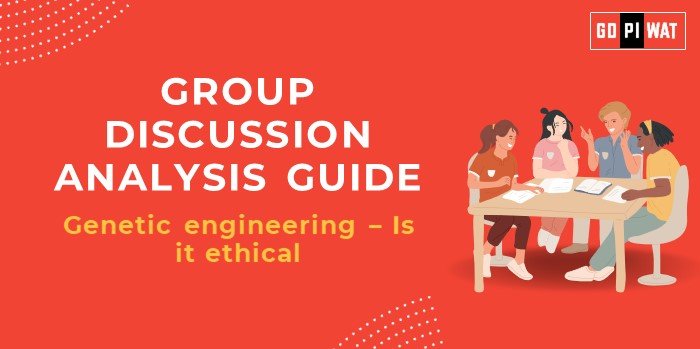📋 Group Discussion Analysis Guide: Genetic Engineering
🌐 Introduction to Genetic Engineering
Genetic engineering, the manipulation of an organism’s genetic code, continues to push boundaries across fields from healthcare to agriculture. However, this cutting-edge technology also invites critical ethical discussions, especially as it approaches human genetic applications.
Originating with research on gene modification in the 1970s, genetic engineering reached a transformative point with CRISPR-Cas9 technology, which allows for precise DNA edits in various organisms, including humans. This advancement, while promising, has raised profound ethical concerns, making it a global debate.
📊 Quick Facts and Key Statistics
● Global GMO Usage: Approximately 190 million hectares of genetically modified crops are grown worldwide, primarily in the U.S., Brazil, and Argentina.
● Human Genome Project Completion: Completed in 2003, it paved the way for advanced genetic research by mapping human DNA.
● Public Opinion: Surveys show around 60% of people worldwide have ethical concerns about genetic modifications in humans, particularly for non-medical applications.
🔍 Stakeholders and Their Roles
- 🌍 Governments and Regulatory Bodies: Set policies and ethical standards for genetic research, such as the FDA (U.S.) and EFSA (Europe).
- 🔬 Biotech Companies: Pioneer innovations in genetic engineering but face public and regulatory scrutiny over ethical practices.
- 🩺 Healthcare Providers: Utilize gene therapies to treat genetic disorders, with potential to expand these treatments in the future.
- ⚖️ Ethics Committees: Oversee moral considerations, especially concerning human genetics.
- 👥 The Public and Advocacy Groups: Shape regulatory policies through public opinion, with varying views on genetic modification.
🏆 Achievements and ⚠️ Challenges
Achievements:
- 🏅 Medical Breakthroughs: Gene therapies, such as for blood disorders, show promise, offering potential cures previously deemed impossible.
- 🌾 Agricultural Advancements: Genetically modified crops resist pests and tolerate harsh climates, improving global food security.
- 💡 Biotechnology Innovation: CRISPR and related technologies allow precise edits, sparking advancements in research and potential treatments for diseases like cystic fibrosis and sickle cell anemia.
Challenges:
- ⚖️ Ethical Dilemmas: Issues such as designer babies and altering the human genome for non-medical reasons are controversial.
- 🌍 Long-Term Safety: Potential environmental and health impacts of releasing genetically modified organisms (GMOs) into ecosystems are uncertain.
🌍 Global Comparisons
Europe: Generally restricts GMOs and gene-editing in humans, prioritizing ethical concerns.
U.S.: Advances faster with fewer restrictions, especially in agriculture and certain medical applications.
📖 Case Studies
China’s Gene-Edited Twins: In 2018, Chinese scientists edited the genes of twin babies, sparking global ethical backlash and calls for regulation.
🗣️ Structured Arguments for Discussion
- Supporting Stance: “Genetic engineering holds the potential to eliminate inherited diseases, enhance agricultural yield, and drive scientific progress.”
- Opposing Stance: “The long-term impact of genetic engineering on ecosystems and human health is unknown, posing ethical risks that outweigh the benefits.”
- Balanced Perspective: “While genetic engineering offers life-saving benefits, ethical boundaries and safety regulations must be in place to prevent misuse and unintended consequences.”
🧠 Effective Discussion Approaches
- Opening Approaches:
- 📊 Data-Driven Opening: “CRISPR has transformed genetic engineering, making DNA editing more accessible than ever, yet ethical concerns persist as public opinion remains divided.”
- 📜 Historical Reference: “From early gene therapy experiments to today’s precise DNA-editing technologies, genetic engineering has sparked both excitement and caution.”
- 🧬 Case Study Introduction: “The gene-edited twins controversy in China emphasizes the ethical risks that come with human DNA manipulation.”
- Counter-Argument Handling: Use examples of medical breakthroughs (like gene therapy for specific diseases) to address ethical concerns while acknowledging the need for safeguards.
⚖️ Strategic Analysis of Strengths and Weaknesses
Strengths:
- ✨ Potential to eradicate genetic disorders
- 🌾 Increased resilience in agriculture
- 💉 Advanced medical treatments
Weaknesses:
- ⚖️ Ethical and moral controversies
- 🌍 Environmental and health risks
- 📜 Regulatory and safety uncertainties
Opportunities:
- 🌍 Tackling global health challenges
- 🌾 Boosting food security
- 💡 Leading biotech innovation
Threats:
- ⚖️ Potential misuse in human enhancement
- 🌿 Biodiversity disruption
- 📣 Resistance from ethical watchdogs and public opinion
📈 Connecting with B-School Applications
Real-World Applications: Genetic engineering can lead to B-school projects in regulatory compliance, innovation in biotech firms, and strategic decision-making for emerging technologies.
Sample Interview Questions:
- 💬 “What role should ethics play in the advancement of genetic engineering?”
- 💬 “How should governments balance innovation with ethical concerns in gene editing?”
Insights for B-School Students: Recognizing the ethical, regulatory, and economic dimensions of genetic engineering can be invaluable for roles in healthcare, biotech, and regulatory consulting.


